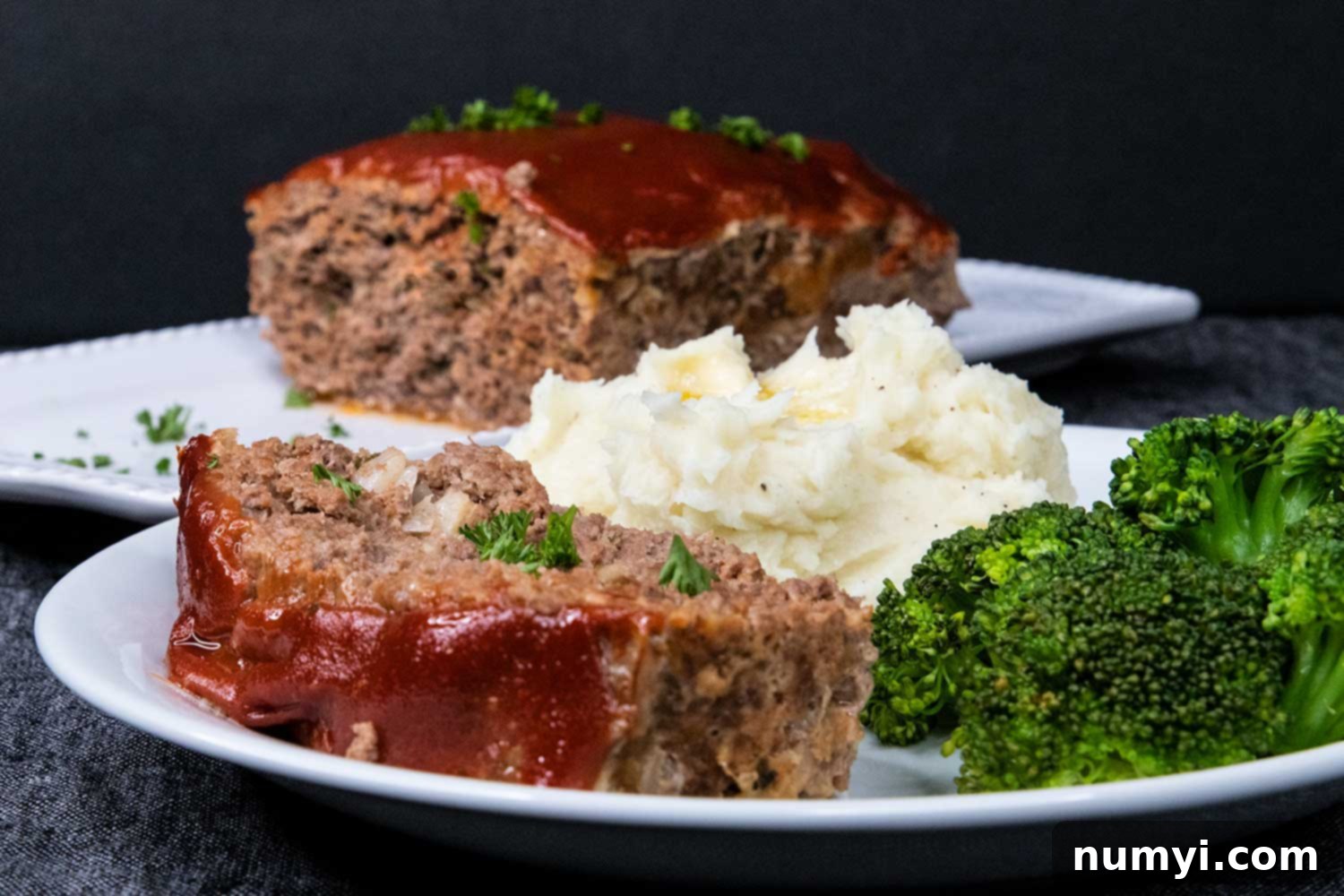The Best Classic Easy Meatloaf Recipe: Juicy, Tender & Perfectly Glazed
There’s something inherently comforting and deeply satisfying about a perfectly cooked meatloaf. It’s a true classic, a timeless dish that evokes cherished memories of family dinners and hearty, home-cooked meals. Our recipe delivers a meatloaf that’s not just simple and easy to make, but also incredibly tender, wonderfully juicy, and bursting with an amazing savory flavor, all crowned with a delicious, tangy-sweet ketchup glaze. Forget any past experiences with dry, crumbly meatloaves; this is the definitive recipe you’ll turn to again and again for a truly comforting and satisfying dinner.
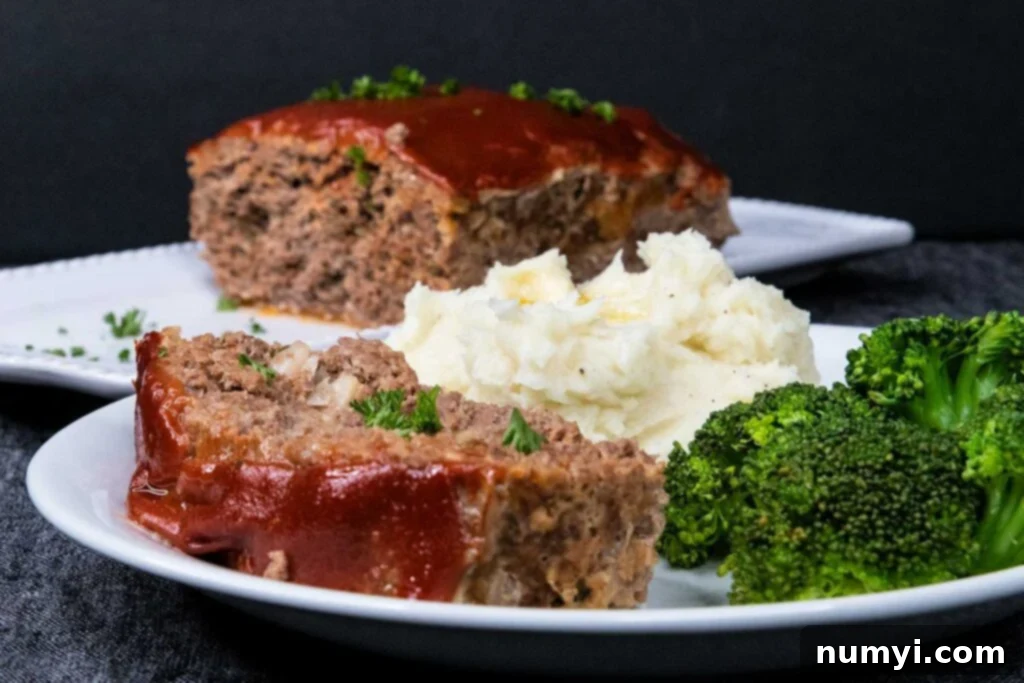
For too long, creating the “perfect” meatloaf felt like a guessing game in many kitchens. I used to just toss in my favorite spices without measuring, leading to inconsistent results – some batches were good, others just okay. We finally decided to take the guesswork out of it and embark on a mission to craft the ultimate foolproof meatloaf. After rigorous testing and precise measuring of every ingredient, we’ve developed what we confidently believe is the best easy meatloaf recipe! This isn’t just another meatloaf; it’s *the* meatloaf – designed for consistent perfection and incredible flavor every single time you make it.
This recipe prides itself on its simplicity, requiring just a few common ingredients that come together effortlessly to create extraordinary flavor. It’s truly hard to go wrong with this foolproof method, making it an ideal choice for busy weeknights when you need a reliable, delicious meal, or a comforting centerpiece for a relaxed Sunday dinner. The magic lies in the carefully balanced combination of ingredients and a specific mixing technique that guarantees a moist, tender, and deeply flavorful result.
How to Make the Best Easy Meatloaf Recipe from Scratch
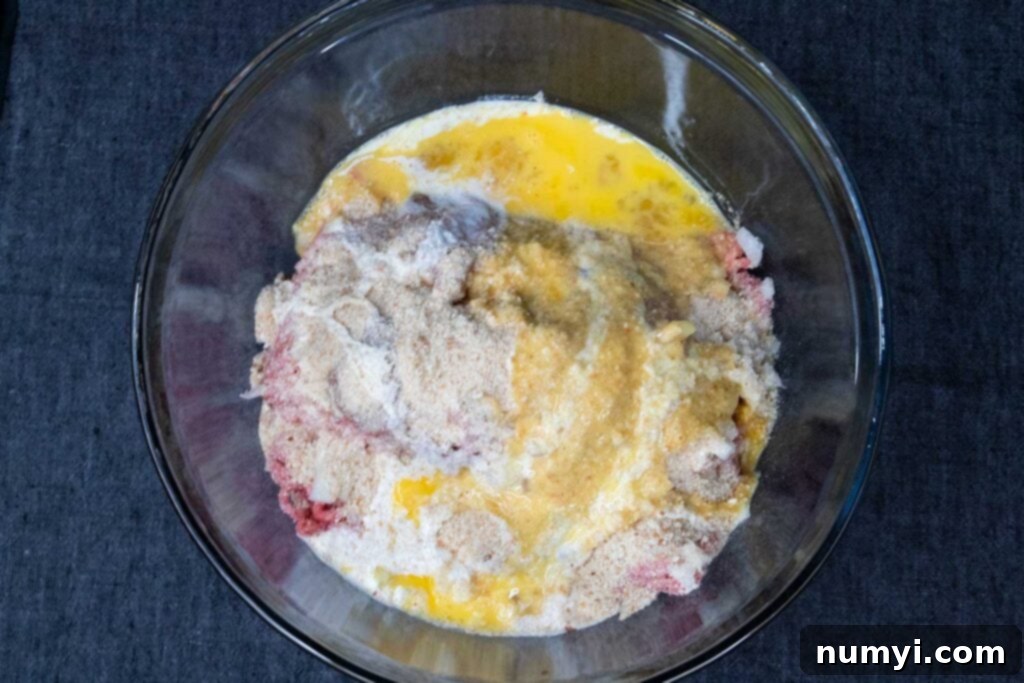
Crafting a truly delicious meatloaf starts with understanding the role of each ingredient and how they contribute to the final taste and texture. We’ve carefully selected components that not only bind the mixture but also infuse it with essential moisture and a rich depth of flavor. Follow these straightforward steps for an unforgettable homemade meatloaf experience.
Essential Ingredients for a Flavorful Meatloaf
- Ground Beef: For the ultimate balance of flavor and moisture, 80/20 ground beef is our top recommendation for this recipe. The “80/20” ratio signifies 80% lean meat and 20% fat. This precise fat content is crucial because it renders beautifully during the baking process, self-basting the meat from within and ensuring a wonderfully juicy and tender texture, thereby preventing the meatloaf from drying out.
- Onions: Finely chopped or grated onions are absolutely essential for adding a foundational savory flavor and contributing to the overall moisture of the meatloaf. Grating the onions can be particularly beneficial as they virtually disappear into the mixture, making them palatable even for picky eaters, while still delivering that vital aromatic punch.
- Eggs and Bread Crumbs: These two ingredients serve as your primary binding agents. Large eggs help to hold all the components together, creating a cohesive structure that prevents the meatloaf from falling apart. Breadcrumbs, on the other hand, absorb excess moisture, contributing to the loaf’s overall tenderness and further aiding in its structural integrity. We typically use plain dried breadcrumbs, but panko breadcrumbs can also be substituted for a slightly lighter texture.
- Buttermilk: This is one of our secret ingredients for achieving unparalleled moisture and a subtle, delightful tang. Buttermilk works to tenderize the meat fibers, ensuring a remarkably soft and juicy meatloaf that truly melts in your mouth. If you don’t have buttermilk on hand, a quick substitute can be made by adding 1 tablespoon of white vinegar or lemon juice to regular milk and letting it sit for 5 minutes until it slightly curdles.
- Worcestershire Sauce, Garlic Powder, Onion Powder, Ketchup, Salt, and Pepper: These carefully chosen seasonings form the savory backbone of our meatloaf. Worcestershire sauce adds a deep, complex umami richness that elevates the beef flavor. Garlic and onion powders provide consistent savory notes throughout the loaf. A touch of ketchup directly in the meat mixture (in addition to the glaze) adds a hint of sweetness and acidity that brightens all the flavors. Finally, freshly ground black pepper and kosher salt are vital for proper seasoning, bringing all the other tastes into perfect harmony.
To begin your meatloaf masterpiece, preheat your oven to a steady 350 degrees F (175 degrees C). This consistent temperature ensures even cooking from the moment your meatloaf enters the oven. Next, prepare a standard 9×5-inch loaf pan by lightly coating it with cooking spray. This simple yet crucial step is vital for preventing the meatloaf from sticking to the pan and allowing for easy removal of your beautifully baked creation.
In a generously sized mixing bowl, combine all the meatloaf ingredients: the 80/20 ground beef, finely prepared onion, large eggs, dried breadcrumbs, Worcestershire sauce, buttermilk, garlic powder, onion powder, ketchup, kosher salt, and fresh ground pepper. Now, here’s a critical tip for achieving that perfect, tender texture: mix the ingredients together gently and just until they are thoroughly combined. It is extremely important to **DO NOT OVERMIX!** Over-mixing the meat can develop the proteins too much, which leads to a dense, tough, and dry texture in your finished meatloaf. For the most effective yet gentle mixing, we recommend using your hands to ensure everything is evenly incorporated without overworking the meat.
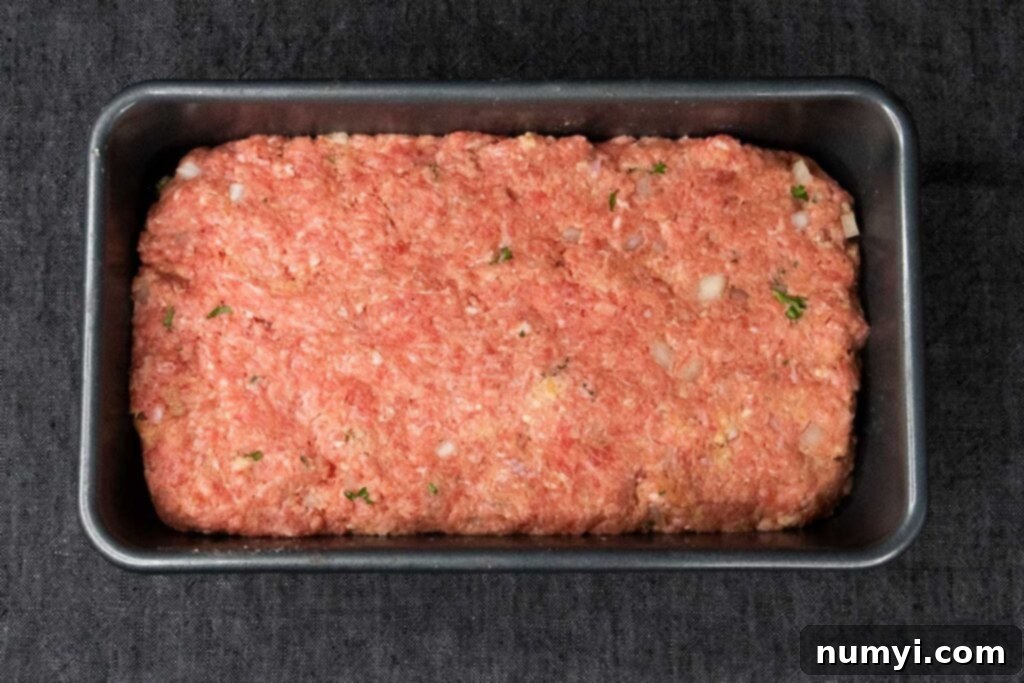
Once your meatloaf mixture is perfectly prepared, press it firmly and evenly into the prepared loaf pan. This step is essential for creating a uniform shape and helping the meatloaf hold together beautifully during both the cooking process and when you slice it for serving. Cover the pan securely with aluminum foil. This initial covering helps to trap steam around the meatloaf, effectively locking in moisture and ensuring it cooks through without drying out. Place the covered loaf pan into your preheated oven and bake for an initial 45 minutes.
The Perfect Tangy-Sweet Ketchup Glaze Ingredients
No classic meatloaf is truly complete without a signature glaze. Our recipe features a simple yet incredibly flavorful sauce that caramelizes beautifully on top, adding another irresistible layer of deliciousness and enhancing the visual appeal of your homemade meal.
- Ketchup: This forms the essential base of our glaze, providing that classic tomato flavor, natural sweetness, and a vibrant red hue.
- Brown Sugar: Adds a deep, molasses-rich sweetness to the glaze, which perfectly balances the tanginess of the ketchup and Dijon mustard. We prefer dark brown sugar for a richer, more complex caramel note.
- Dijon Mustard: Offers a sharp, zesty kick that beautifully cuts through the sweetness of the other ingredients, elevating the overall complexity and depth of the glaze’s flavor profile.
- Worcestershire Sauce: Just a dash of Worcestershire sauce is all it takes to deepen the savory notes and infuse the glaze with an irresistible umami factor, making it truly stand out.
While the meatloaf is undergoing its initial bake in the oven, take a few moments to prepare your delectable, tangy-sweet glaze. In a small bowl, combine the ketchup, brown sugar, Dijon mustard, and Worcestershire sauce. Whisk these ingredients together thoroughly until you achieve a smooth, well-blended sauce with a consistent texture. This simple yet powerful sauce is what will truly transform your meatloaf from good to absolutely amazing!
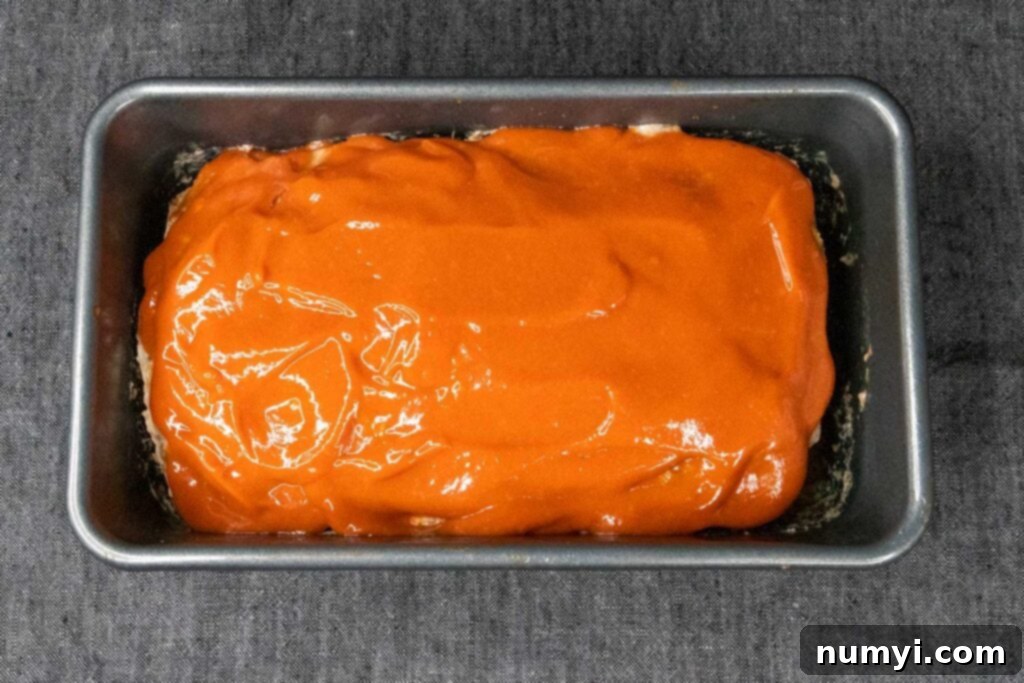
After the initial 45 minutes of baking with the foil cover, carefully remove the loaf pan from the oven. Gently discard the aluminum foil. Now, it’s time for the star topping to shine! Spread the prepared tangy-sweet ketchup glaze generously and evenly over the top surface of the partially baked meatloaf. Return the uncovered pan to the oven and continue baking for another 30 minutes. The meatloaf is perfectly cooked and safe to eat when an internal meat thermometer, inserted into the thickest part of the loaf (avoiding the pan), reads 160 degrees F (71 degrees C). This ensures it’s thoroughly cooked while remaining wonderfully moist.
One of the most crucial steps for achieving a perfectly structured, incredibly juicy, and easy-to-slice meatloaf is allowing it adequate resting time. Once baked to perfection, remove the pan from the oven and let the meatloaf rest undisturbed for at least 10 minutes. This essential resting period allows the internal juices to redistribute evenly throughout the meat, preventing them from escaping when you begin to slice it. After resting, carefully turn the meatloaf out of the pan onto a cutting board and slice it into thick, satisfying portions. Serve immediately and enjoy!
Expert Tips and Frequently Asked Questions for Perfect Meatloaf
Achieving meatloaf perfection is simpler than you might think, especially with a few key insights and answers to common questions. Here are our top tips to ensure your homemade meatloaf is always a crowd-pleaser: tender, juicy, and full of flavor.
What is the best meat for meatloaf? For a truly rich flavor and incredibly moist texture, we unequivocally recommend using 80/20 ground beef. The “80/20” ratio signifies 80% lean meat and 20% fat. This particular fat content is essential as it renders during the cooking process, effectively self-basting the meat from within and preventing it from drying out. While leaner beef (like 90/10) can be used, you might find the resulting meatloaf to be less juicy and potentially a bit drier. Some recipes explore incorporating a blend of meats such as ground pork, veal, or even sausage for added complexity and moisture, but 80/20 ground beef alone provides consistently excellent and satisfying results.
Why does my meatloaf fall apart when cutting? This is a common issue that many home cooks face, and it usually boils down to one of two main factors: insufficient mixing of the ingredients or not pressing the mixture firmly enough into the loaf pan. The eggs and breadcrumbs in the recipe act as crucial binding agents, but they need to be thoroughly, yet gently, incorporated throughout the entire meat mixture to create a cohesive structure. If these binders aren’t well distributed, the loaf simply won’t hold together when sliced. Additionally, firmly pressing the meatloaf mixture into the pan removes any significant air pockets and compacts the meat, which is vital for maintaining its shape. And don’t forget the importance of the resting period after baking; it allows the internal structure of the meatloaf to set and the juices to redistribute, further preventing crumbling.
How long does it take to bake a 2 pound meatloaf? A standard 2-pound meatloaf, baked in a 9×5-inch loaf pan at 350 degrees F (175 degrees C), typically requires a total baking time of approximately 1 hour and 5 minutes to 1 hour and 15 minutes. This timeframe includes both the initial covered baking period and the final uncovered baking with the glaze. The most accurate and safest way to determine doneness is always by using an instant-read meat thermometer. Insert the thermometer into the thickest part of the meatloaf, ensuring it reads a safe internal temperature of 160 degrees F (71 degrees C). Always allow for slight variations based on your individual oven’s calibration and the exact thickness and density of your loaf.
Do I have to use a loaf pan? While not strictly mandatory, we highly recommend using a loaf pan for the best possible results with this recipe. You *can* shape the meatloaf mixture into a free-form loaf and bake it directly on a baking sheet. However, this method comes with a few potential drawbacks: the exposed edges tend to cook much faster and can become quite dry and even crispy before the center of the loaf is fully cooked. A loaf pan, conversely, helps to contain all the delicious juices and ensures a more even moisture distribution throughout the entire meatloaf, resulting in a consistently tender and juicy product from edge to center. If you do choose to opt for a baking sheet, be prepared for varied cooking times and potentially a less moist outcome.
Can you freeze meatloaf? Absolutely! Meatloaf is an excellent candidate for freezing, making it perfect for efficient meal prep, saving time on busy days, or simply preserving delicious leftovers.
Freezing raw meatloaf: Prepare the meatloaf mixture according to the recipe instructions. Instead of baking it immediately, press the mixture into your loaf pan (or shape it into a free-form loaf if preferred). Cover it tightly with several layers of plastic wrap, followed by a layer of heavy-duty aluminum foil to prevent freezer burn. Label and freeze for up to 3 months. When you’re ready to bake, defrost the meatloaf slowly in the refrigerator overnight, keeping it covered. Then, proceed with the baking instructions as usual, potentially adding about 10-15 minutes to the total baking time if it’s still very cold.
Freezing cooked meatloaf: Allow the baked meatloaf to cool completely to room temperature before freezing. This step is crucial to prevent the formation of ice crystals. You can freeze individual slices for ultimate convenience or the entire remaining loaf. For slices, place them on a parchment-lined baking sheet and freeze until they are solid. Once frozen, wrap each slice individually in plastic wrap, then transfer them to a larger freezer-safe bag or an airtight container. For a whole loaf, wrap it tightly in plastic wrap and then aluminum foil. Freeze for up to 3 months. To reheat, thaw the frozen meatloaf or slices in the refrigerator, then warm them gently in the oven (covered with foil to retain moisture) or in the microwave until heated through to an internal temperature of 165°F (74°C).
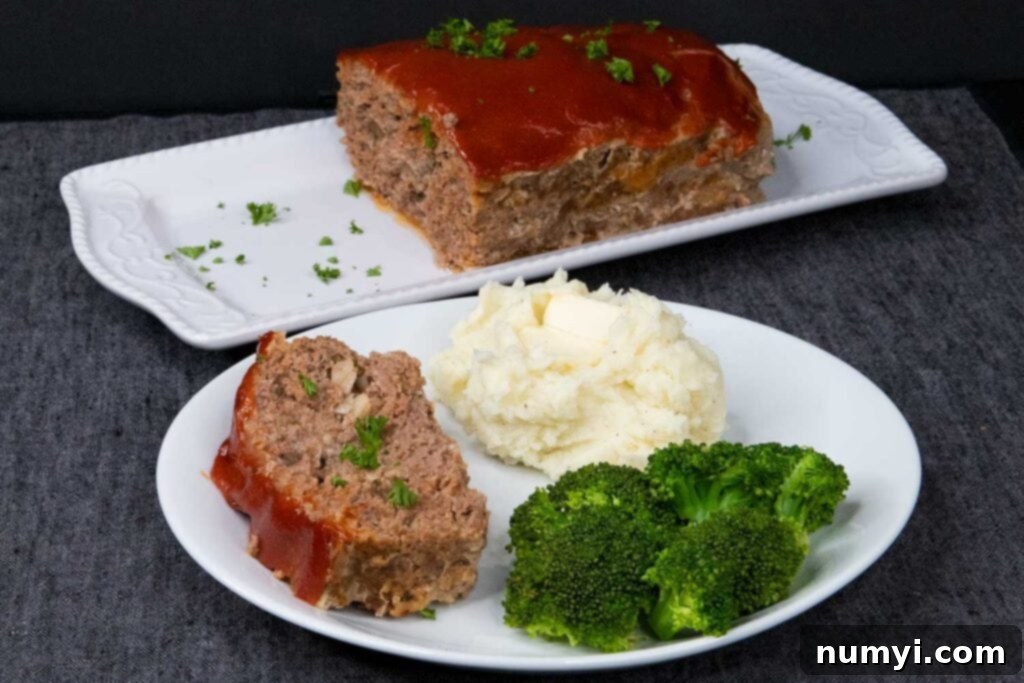
What to Serve with Your Delicious Homemade Meatloaf
A classic meatloaf dinner isn’t truly complete without the perfect array of side dishes to complement its rich and savory flavor. We always pair this hearty meatloaf with creamy, dreamy mashed potatoes, which are absolutely ideal for soaking up any extra glaze or savory juices, alongside a refreshing side of fresh green beans or steamed broccoli for a balanced meal. However, the possibilities are endless! Other fantastic options include beautifully roasted root vegetables (such as carrots, parsnips, and potatoes), a simple crisp green salad with a light vinaigrette, sweet corn on the cob, or even a decadent mac and cheese for an extra dose of comfort. Don’t be afraid to experiment with your favorite seasonal vegetables or other comforting classics!
Other Comfort Food Recipes You Might Enjoy!
If you’ve loved making and enjoying this classic easy meatloaf, you’re sure to find these other hearty and delicious comfort food recipes from our kitchen equally satisfying. Explore more of our family favorites!
- Stuffed Bell Peppers Recipe
- Absolute Best Ever Lasagna Recipe
- Slow Cooker Beef Stew
- Easy Vegetable Beef Soup
- Sheet Pan Beef Nachos
- Salisbury Steak with Mushroom Gravy
- Thick and Hearty Homestyle Chili Recipe
Whether it’s a bustling weeknight or a relaxed weekend, this easy meatloaf recipe promises a satisfying, flavorful, and truly comforting meal that the whole family will adore. Dive into a generous slice of pure homemade comfort food today and discover your new favorite way to make meatloaf!
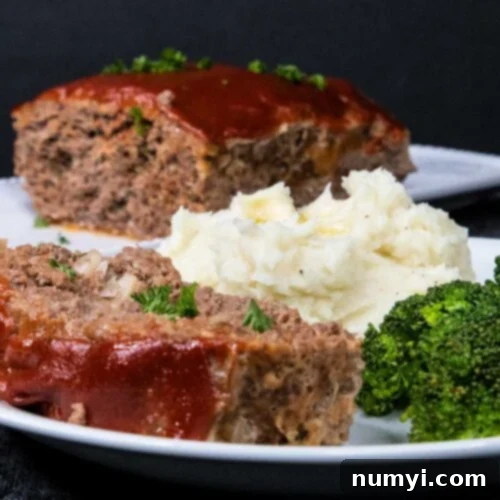
Easy Classic Meatloaf Recipe
Print
Pin
Rate
Ingredients
Meatloaf
- 2 lbs 80/20 ground beef
- 1/2 cup onion, diced small (or grated)
- 2 large eggs
- 1/2 cup dried breadcrumbs
- 1/3 cup buttermilk
- 1 tbsp Worcestershire sauce
- 1/2 tsp garlic powder
- 1/2 tsp onion powder
- 1/4 cup ketchup
- 1 tsp kosher salt
- 1/2 tsp fresh ground pepper
Meatloaf Sauce
- 1/2 cup ketchup
- 2 tsp dijon mustard
- 1 tsp Worcestershire sauce
- 2 tbsp dark brown sugar
Instructions
-
Preheat the oven to 350 degrees F (175 degrees C). Prepare a 9×5-inch loaf pan with cooking spray, and set aside.
-
In a large bowl, add the ground beef, onion, eggs, bread crumbs, Worcestershire sauce, buttermilk, garlic powder, onion powder, ketchup, salt, and pepper. Mix the ingredients together gently just until combined. DO NOT OVERMIX, as this can lead to a tough, dry meatloaf.
-
Press the mixture firmly into the prepared loaf pan. Cover the pan securely with aluminum foil and bake for 45 minutes.
-
While the meatloaf is baking, prepare the glaze: In a small bowl, stir together the ketchup, brown sugar, Dijon mustard, and Worcestershire sauce until smooth.
-
Remove the pan from the oven and discard the foil. Spread the prepared glaze evenly over the top of the meatloaf. Return the uncovered pan to the oven and bake for another 30 minutes, or until the internal temperature of the meatloaf reaches 160 degrees F (71 degrees C) on an instant-read thermometer.
-
Let the meatloaf rest for at least 10 minutes before turning it out of the pan and cutting it into thick slices. This allows the juices to redistribute for a tender and juicy result.
Nutrition
